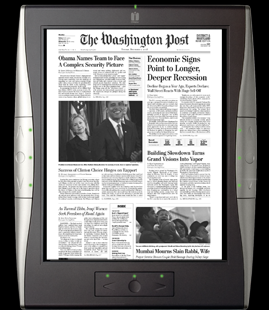Citizen Pain: Who Needs Another Electronic Reader?

So today’s the day when reviews are coming in from CNet and Between The Lines on the second edition of Amazon’s Kindle electronic book reader. You decide whether you want to spend $350-plus for a device that lets you, essentially, read one type of publication.
The Kindle has yet to become the kind of sales sensation that will mark it as the iPod of the book business. Yet, before that verdict is in, Hearst wants you to buy yet another special-purpose reader.
Hearst, of course, traces its lineage, most famously, to William Randolph Hearst, who was one of the most famous newspaper publishers in the era of the broadest of the broadsheets. He inherited the San Francisco Examiner and squared off against Joseph Pulitzer's New York World with the New York Journal in a dustup of screaming sensationalism. Hearst inspired the main character in Orson Welles' classic movie, Citizen Kane.
Hearst, the corporation, is now publisher of the San Francisco Chronicle and O: The Oprah Magazine. The company plans to introduce another companion to your mobile phone and laptop (and Kindle) that will have a screen that is expected to be about the size of a sheet of paper, as opposed to the Kindle’s six-inch size.
This will make it easier to read magazines and newspapers, which are near and dear to Hearst’s heart and bottom line.
But the question here is, clearly, how many readers do you really want to carry around?
And, when you get down to it, if you need a large-format reader, why the laptop itself isn’t suitable?
Why not try simply to make use of the huge installed base of screens 13” and up? Or at least build on the use of tablet computers? Why re-invent the PC?
It’s not like this hasn’t been thought of before. In fact, Arthur C. Clarke envisioned a Newspad in 1968, that he expected would be used on Earth and elsewhere in 2001, in his space odyssey. Didn’t happen. But the laptop did.
If Hearst wants a large-format reader, there’s already the iRex Iliad. That’s supposed to give you access to the Guardian and other international newspapers, as well as the Washington Post.
But if it’s as slow to load as this review of that reader, then Hearst’s reluctance to adopt it is understandable.
The folks who introduced the Iliad though have also figured out a pretty good means for displaying what looks-like full-size newspaper front pages on a browser. Just check out pressdisplay.com.
You can narrow down selections to the newspapers that are of interest to you. You can mix them all together, into one automated presentation. You can let the editors’ choices of the top stories to rule – or replace with the readers’ choices. Do they vote? No. The system just tracks the length of time spent with each story by each reader. That’s the vote.
It’s not as if the newspaper and magazine industry haven’t gone down this path before. Knight-Ridder rolled out its videotex system a quarter-centurty ago and was sorely disappointed that people didn’t buy its dedicated machines. And Knight-Ridder even set up an Information Design Laboratory that was going to come up with the kind of large-format, flat-screen device that would propel print publications into the 21st Century. Didn’t happen.
About three years ago, the kind of device that might fulfill that vision seemed on the cusp of arriving. There was a bit of buzz about a large-format reader that you could just rollup and put in your coat pocket or briefcase.
Don’t see any in any hands today. Still, if that was durable, reliable and could pull in any news source – from the Web – you might have something.
Until then, if you want a large-screen device, it’s a lot smarter to adapt what you’re doing to the roughly 38 million that get sold every three months.
Instead of trying to find space for yet another display device in what people carry around.
